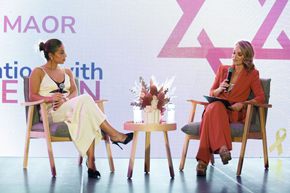Forged in fire: Gaza war showcases women’s integration into the IDF
“It’s amazing how, in this war, you see female doctors, paramedics and pilots. You hear them on the radio and you see them on the ground. Gradually the barrier was broken,” Lt. Col. Shani Kisri, medical chief of the Israel Defence Forces’ 162nd Division, told JNS on Friday.
The integration of women into front-line positions, Kisri said, started approximately in the beginning of the ’90s. By 1996, there were female paramedics embedded in various battalions, with the Golani Brigade being the pioneer.
After her return to service in 2010 after graduating from medical school, Kisri became the first-ever battalion doctor for an Israeli infantry brigade.
During 2014’s “Operation Protective Edge,” Kisri noted, she was likely the only female doctor in the Gaza Strip.

Soldiers of the IDF’s Bardales Battalion prepare for urban-warfare training on a foggy morning in southern Israel July 13, 2016. Some 51 percent of the soldiers in the Bardales Battalion, an infantry combat unit, are women. Credit: Hadas Parush/Flash90.
“I was in a special unit back then. The female paramedics were less present on the battlefield. Now you see them everywhere. There are more female pilots, paramedics, doctors and females in special operations units. This war gave us a chance to prove that it works,” she said.
“They proved they can do the job, handle the rough conditions and the long fighting period. ‘Protective Edge’ was a few weeks and it was hard. This war has lasted over a year now. I have paramedics who have been in the field for months. It’s not easy and they handled it perfectly,” she added.
“Gradually we will see that more and more females are integrated into more battlefield positions because at the end of the day, the army needs good people with motivation to serve and whether it’s a male or female, today, we know it doesn’t really matter,” she told JNS.

Women in the armoured forces of the Israel Defence Forces at a staging area near the border with Gaza on Jan. 1, 2024. Photo by Tomer Neuberg/Flash90.
There are a few difficulties, Kisri noted, especially for female medical corps soldiers.
“Usually, you’re the only female around, especially if you’re a doctor or paramedic at the platoon level. You might be the only female among a few dozens of men,” she said.
“You might find yourself, especially in this war, serving for weeks on the battlefield with no interactions with other females, no private quarters, no showers and everything that comes with joint service,” she continued.
Still, “I think we are getting better at understanding the difficulties and supporting the female paramedics and doctors,” she said. “They are very highly motivated, very qualified and there is a big demand for female doctors and paramedics in the battalions now. So it’s working.”

An all-female IDF tank crew that fought on Oct. 7, 2023. Source: Channel 12 News screenshot.
The reason for females often finding themselves alone in a battalion is that they have not yet been integrated into the infantry the way they have been into the medical corps, she said.
“The medical corps is more progressive in this aspect. When the medical corps puts a paramedic in a position, it does not take into account whether the person is male or female, it’s based on experience and qualifications,” she said.
“Being a medical corps personnel in a battalion, coming from a different place, can feel a bit isolating compared to soldiers who went through the entire service together. You have to find your place. Most paramedics integrate quite well,” she continued.

The IAF’s five new women UAV operators, Dec. 9, 2020. Credit: IDF Spokesperson’s Unit
“They get a lot of respect, they tell everybody what to do, they are very assertive and the soldiers take care of them. It’s not easy in battlefield conditions, but the male and female soldiers find solutions,” she added.
Kisri told JNS she has over 40 paramedics in her division and does find women to have more issues than men.
“You sometimes see a paramedic, she is half the size of most of the male soldiers, carrying a bag twice her bodyweight. She won’t stop because she wants to prove that she can do it so that nobody says she can’t because she is a female or because she’s a paramedic,” she said.

A military helicopter takes off after bringing wounded soldiers from the Gaza Strip to the Tel Aviv Sourasky Medical Center on Nov. 8, 2023. Photo by Avshalom Sassoni/Flash90
“This motivation is highly appreciated by the male soldiers, who usually trust the trial by fire. Once you’ve proven yourself to be equipped to carry your gear and especially once you take care of the first wounded soldiers and have to perform under battlefield conditions, even the most sceptical are convinced,” she added.
With regard to the hostages kidnapped by Hamas on Oct. 7, 2023, Kisri said the big difference wasn’t between female and male soldiers but rather between soldiers and civilians.
“When you’re a soldier, you go into the army knowing what you’re getting yourself into and the risks you are willing to take, as a male or a female. I don’t think society should tell women that because of their gender the risk is higher. If somebody is willing to take the risk it’s their decision,” she said.

Soldiers from the IDF’s 99th Division during operational activities in the central Gaza Strip in an undated photo from November or December, 2024. Credit: IDF.
Ensuring that women are treated as equals, Kisri said, falls under the responsibility of the commander, who monitors that the right values are upheld and that soldiers behave in an appropriate manner.
“I do have a lot of females in the field, and I see it as my personal responsibility to make sure that my paramedics and doctors are treated with respect and appropriately. I don’t have many examples to give you of bad incidents,” she said.
“We talk to commanders about it. We don’t just wait for something to happen, we create boundaries, specific orders and rules and enforce them strictly,” she added.
While 86% of units in the army are open to women, Kisri said the number of women within these units is also increasing.
When she was in the field, “We were maybe three female doctors in infantry battalions,” she said. “Today it’s more than 50%. It’s not only about the type of positions that are open, it’s also about the number of women that fill those positions,” she said.
“If you open your mind to the female soldiers, you’ll do so with other minorities. There were other minorities being integrated even before females. Everything is intertwined,” she said.
“I think the army is one of the most progressive places. Sometimes Israeli society should aspire to be more like the army,” she added.







